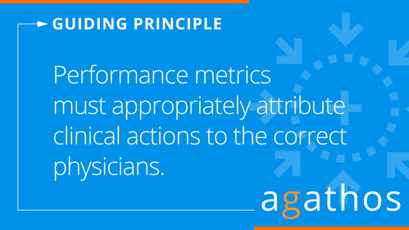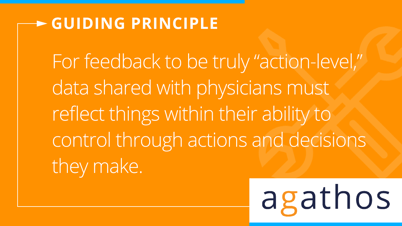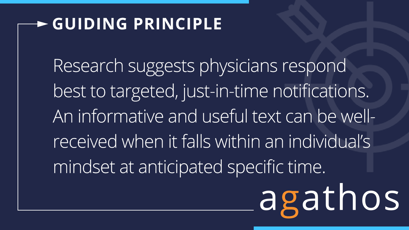A DATA RECIPE PHYSICIANS WILL BITE INTO
- John "JP" Pollard
- 04/6/2022
Over the last few years, many of us have invested spare time trying out the many culinary delights of the world. Some jumped on the bread craze. Many others have just tried new meal recipes to keep life interesting while in lockdown. Regardless of what you have been cooking or baking, you know how important the ingredients are — and the process is — to a solid outcome.
Many of you who lead physicians have a different type of dish to cook. You are looking for that secret recipe that hits the quadruple aim — better patient outcomes, reduced costs, patient satisfaction, and provider satisfaction. In a world where performance improvement is driven by analytics, and in light of the promise of stories relayed in books like Moneyball, many clinical leaders look to data to provide the secret sauce that helps achieve that quadruple care aim.
The most critical ingredients
After surveying the many approaches available, we at Agathos have come to believe that achieving the quadruple aim requires a fusion of four interdependent ingredients. Take one ingredient away and the recipe is ruined (as are any hopes of achieving your goals). Consider these ingredients:
- data that physicians trust
- data that physicians will engage with
- data that informs and motivates change in practice patterns
- measurable change in practice patterns
When these four ingredients are meticulously combined, your metaphorical hospital kitchen is filled with the aroma of one tasty final dish — the quadruple aim as achieved through data toward better care. Let’s look at these ingredients in more detail.
Data that physicians trust
If you have been sending data to physicians in your group, you already know that non-credible data and, particularly, non-credible attribution, are showstoppers. Credible data is the core ingredient to your recipe, and this is not always an easy ingredient to find. For example, you cannot afford to use attributions like “last touch” when reporting on practice patterns that occurred early in the hospital stay. You know healthcare is a team sport with many cooks in the kitchen. (Yes, I just mixed metaphors.) Ensuring that all clinical activities, inactivities, and decisions are properly attributed to all involved providers is a rare ingredient, and yet critical. Pick your ingredients wisely.

Data that physicians will engage with
Beyond having data that is trustworthy, another often skipped ingredient in a data solution is data that physicians will actually engage with. Many leaders create dashboards and share in meetings or potentially send screenshots in emails with the hopes that physicians will dig in and make use of that data. Inevitably, this approach falls flat. It is a lot of work for you, and the “ingredient” is extremely hard to “cook with.” In the case of dashboards, the “chefs” (physicians) may not even know that the “ingredient” (credible data on practice patterns) exists, or may experience dashboards like a complicated cookbook (time-consuming and difficult to use) when what they really want is a quick and easy recipe for the busy professional.
What would a quick and easy recipe look like?
Continuing this metaphor, the quick and easy recipe would look like this:
-
- Individualized data is sent via text to the physician.
- The physician reviews the text at a convenient time.
- Physicians can see how they compare to their peers.
- Curiosity piqued, physicians engage, collaborate, and improve care.
Data that informs and motivates change in practice patterns
Obviously, if your group’s physicians will not engage with data, that data cannot bring about a change in practice patterns. and yet you need more ingredients than engagement to get to the results you seek. That ingredient is data that is actionable. This means, the type of data offered to physicians must be specific enough and regarding an area over which the physician has some control and capacity to change. Most data is so broad that it leaves a physician with a shrug, saying “ok, but what can I do about that?”
 Give the physician something they can act upon, and now you are truly cooking.
Give the physician something they can act upon, and now you are truly cooking.
The forth critical ingredient — changed behaviors
You can have the most exquisite, organic ingredients and still ruin a recipe. Often recipes have stages where you combine a limited set of ingredients to create a texture or consistency that is critical to move on. That is much like the ingredient of changed behaviors. It is a combination of the other ingredients, masterfully combined to complete a subset of the steps that will lead to your final dish.
Many healthcare leaders are concerned with metrics such as reducing length of stay. These are important to track. However, at least with respect to leveraging data and enlisting physicians toward such goals, we feel that focusing on practice changes (as enabled by data physicians trust and will engage with) is more important than a focus on outcomes by themselves. If the combination of other ingredients leads to a step in the recipe called changed behaviors, then our tasty dish is only a matter of simmering for a time to thoroughly cook through and ensure a long-term change in culture.
The final dish — the quadruple aim
With those four ingredients, properly marinated and cooked, we have the best chance at achieving the dish we intended: the quadruple aim.
Reduced costs
We alluded to one part of the quadruple aim in the prior section on outcomes. Clearly when we modify practice patterns to reduce length of stay or improve patient flow we can reduce costs. So those are a few clear examples of cost savings. At a higher, aggregate level, we are able to deliver a return on investment to our partners that exceeds 200% of our hospitals’ investment. What, then, of the other three aspects of the quadruple aim?
Patient experience
A number of Agathos insights that have a strong impact on the patient experience. Consider, for example, the impact of getting discharge orders in by 11 a.m., or what a reduction in daily comprehensive metabolic panels might do, or how scheduling PT/OT consults earlier in a hospital stay will help the patient be discharged in a timely manner. (See our blog post on patient flow). Improvements to all of these measurable practice patterns (and many more) can have a sizable impact on patient satisfaction.
Physician experience
What about the physician? We have learned a few unexpected things about physicians in bringing Agathos to market. First, while one might think that physicians would be opposed to unblinded peer comparison, we are finding that they actually appreciate that aspect of the approach. As physicians receive a text each week, they become curious about their own practice patterns in comparison to their peers. This leads to communication and collaboration with their peers that ultimately leads to increased engagement. As one CMO recently shared with me, “Physician burnout is partially related to the fact that we’ve stopped talking to one another. The more we can engage in meaningful dialogue, scientific dialogue, arguments, debates between professional colleagues, the better we can build relationships.” Some physicians share that they haven’t experienced this type of collaboration since residency and they really enjoyed what Agathos has brought to their organization.
Better patient outcomes
The goal of medicine is to improve patient health. The research shows that when we reduce clinical variation the probability of improving healthcare outcomes is much higher. So, as we show physicians how they compare to one another in practice patterns, and as they modify their own behavior — without any heavy administrative involvement — the likelihood of having not only a better patient experience, but also better outcomes increases as well.
The guiding principles in our kitchen
We gave you our recipe for achieving the quadruple aim. Obviously we are one dish on the menu and we complement a number of other dishes that you may be considering. To help you get a better idea of the principles that guide our metaphorical kitchen, we have a white paper called 5 ways to empower physicians with their clinical data. Some of the guidelines have appeared in graphics throughout this post. Give the white paper a look and then let us know if you’d like to discuss a little taste test.
About Author

John "JP" Pollard
JP has over 25 years of marketing experience ranging from executive and product management roles to leadership at award-winning agencies. He has marketed for American Airlines’ SABRE division, SAP’s Germany-based services organization, and also for startups in supply chain technology and healthcare. Prior to joining Agathos in October 2021, JP was VP of marketing for healthcare consulting firm Nordic Consulting Partners (now Nordic Global).


